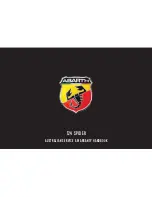
ESC uses sensors in the vehicle to determine the vehicle
path intended by the driver and compares it to the actual
path of the vehicle. When the actual path does not match
the intended path, ESC applies the brake of the appro-
priate wheel to assist in counteracting the oversteer or
understeer condition.
•
Oversteer - when the vehicle is turning more than
appropriate for the steering wheel position.
•
Understeer - when the vehicle is turning less than
appropriate for the steering wheel position.
The “ESC Malfunction Indicator Light” located in the
instrument cluster will start to flash as soon as the tires lose
traction and the ESC system becomes active. The “ESC
Malfunction Indicator Light” also flashes when the TCS is
active. If the “ESC Malfunction Indicator Light” begins to
flash during acceleration, ease up on the accelerator and
apply as little throttle as possible. Be sure to adapt your
speed and driving to the prevailing road conditions.
WARNING!
Electronic Stability Control (ESC) cannot prevent the
natural laws of physics from acting on the vehicle,
nor can it increase the traction afforded by prevailing
road conditions. ESC cannot prevent accidents, in-
cluding those resulting from excessive speed in
turns, driving on very slippery surfaces, or hydro-
planing. ESC also cannot prevent accidents resulting
from loss of vehicle control due to inappropriate
driver input for the conditions. Only a safe, attentive,
and skillful driver can prevent accidents. The capa-
bilities of an ESC equipped vehicle must never be
exploited in a reckless or dangerous manner which
could jeopardize the user’s safety or the safety of
others.
The ESC system has two available operating modes in
AWD AUTO range and two-wheel drive vehicles, and
one operating mode in AWD LOW range.
494
STARTING AND OPERATING
Summary of Contents for 2013 Durango
Page 1: ...Durango O W N E R S M A N U A L 2 0 1 3 ...
Page 4: ......
Page 9: ...1 INTRODUCTION 7 ...
Page 12: ......
Page 162: ...160 UNDERSTANDING THE FEATURES OF YOUR VEHICLE ...
Page 163: ...3 UNDERSTANDING THE FEATURES OF YOUR VEHICLE 161 ...
Page 164: ...162 UNDERSTANDING THE FEATURES OF YOUR VEHICLE ...
Page 308: ......
Page 314: ...INSTRUMENT CLUSTER 312 UNDERSTANDING YOUR INSTRUMENT PANEL ...
Page 439: ...Operating Tips Chart 4 UNDERSTANDING YOUR INSTRUMENT PANEL 437 ...
Page 440: ......
Page 513: ...5 STARTING AND OPERATING 511 ...
Page 677: ...INDEX 10 ...
Page 697: ......
















































